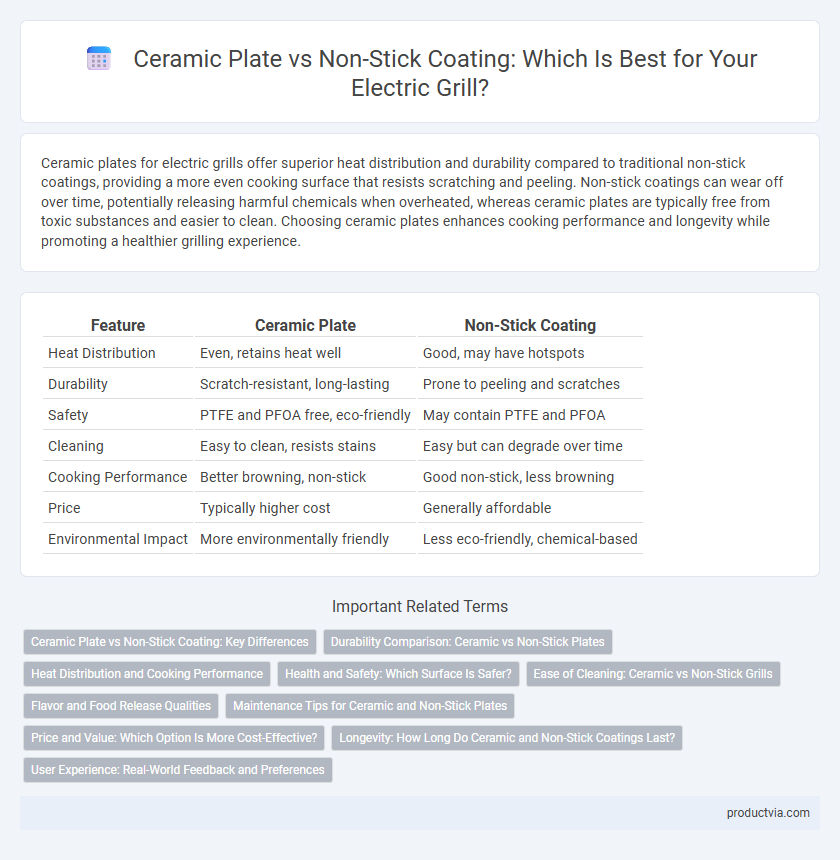Ceramic plates for electric grills offer superior heat distribution and durability compared to traditional non-stick coatings, providing a more even cooking surface that resists scratching and peeling. Non-stick coatings can wear off over time, potentially releasing harmful chemicals when overheated, whereas ceramic plates are typically free from toxic substances and easier to clean. Choosing ceramic plates enhances cooking performance and longevity while promoting a healthier grilling experience.
Table of Comparison
| Feature | Ceramic Plate | Non-Stick Coating |
|---|---|---|
| Heat Distribution | Even, retains heat well | Good, may have hotspots |
| Durability | Scratch-resistant, long-lasting | Prone to peeling and scratches |
| Safety | PTFE and PFOA free, eco-friendly | May contain PTFE and PFOA |
| Cleaning | Easy to clean, resists stains | Easy but can degrade over time |
| Cooking Performance | Better browning, non-stick | Good non-stick, less browning |
| Price | Typically higher cost | Generally affordable |
| Environmental Impact | More environmentally friendly | Less eco-friendly, chemical-based |
Ceramic Plate vs Non-Stick Coating: Key Differences
Ceramic plates on electric grills provide superior heat retention and distribution, ensuring even cooking and consistent temperature control, while offering a chemical-free, scratch-resistant surface that maintains durability over time. Non-stick coatings, typically made from PTFE or similar materials, allow for easy food release and quick cleanup but may deteriorate faster under high heat and require careful use to avoid scratching or peeling. The choice between ceramic plates and non-stick coatings depends on priorities like long-term durability, cooking performance, and maintenance preferences.
Durability Comparison: Ceramic vs Non-Stick Plates
Ceramic plates on electric grills offer superior durability due to their resistance to scratches, high temperatures, and wear compared to traditional non-stick coatings which can degrade and peel over time. They maintain their smooth surface longer, ensuring consistent cooking performance and easier cleaning. In contrast, non-stick coatings typically require more careful handling and frequent replacement to avoid loss of effectiveness and potential health risks from flaking.
Heat Distribution and Cooking Performance
Ceramic plates in electric grills provide superior heat distribution due to their consistent surface temperature, ensuring even cooking without hot spots. Non-stick coatings offer excellent food release but may experience uneven heating, leading to occasional hotspots and inconsistent cooking performance. The ceramic option typically enhances grilling efficiency and food texture, while non-stick coatings prioritize easy cleanup.
Health and Safety: Which Surface Is Safer?
Ceramic plates for electric grills are generally considered safer due to their natural, non-toxic composition that prevents harmful chemicals from leaching into food when heated. Non-stick coatings, often made from polytetrafluoroethylene (PTFE), can release toxic fumes if overheated above 500degF, posing potential health risks. Choosing ceramic surfaces reduces exposure to these hazardous emissions, promoting a healthier and safer cooking environment.
Ease of Cleaning: Ceramic vs Non-Stick Grills
Ceramic plates on electric grills offer superior ease of cleaning due to their non-porous surface, which resists food sticking and allows effortless wiping after use. Non-stick coatings also provide convenient cleanup but can degrade over time, requiring careful maintenance to avoid scratches and peeling. Choosing ceramic surfaces enhances durability and maintains a pristine condition with minimal cleaning effort, making them ideal for frequent grilling.
Flavor and Food Release Qualities
Ceramic plates on electric grills offer superior flavor preservation by providing even heat distribution that enhances the natural taste and texture of grilled foods. Non-stick coatings excel in food release qualities, allowing easy removal of delicate items without sticking, reducing the need for excessive oils or fats. Both options contribute to healthier grilling, but ceramic plates tend to retain more authentic flavors while non-stick coatings prioritize convenience in cleanup and maintenance.
Maintenance Tips for Ceramic and Non-Stick Plates
Ceramic plates on electric grills require gentle cleaning with non-abrasive sponges and mild detergents to maintain their smooth surface and prevent cracking. Non-stick coated plates need careful avoidance of metal utensils and abrasive cleaners to preserve the coating's integrity and prevent peeling. Both types benefit from regular wiping after use and avoiding high heat to prolong durability and performance.
Price and Value: Which Option Is More Cost-Effective?
Ceramic plates for electric grills often have a higher upfront cost but offer superior durability and resistance to scratches, resulting in longer-term savings despite the initial investment. Non-stick coatings are generally more affordable initially but may require more frequent replacement due to peeling or wear, increasing overall expense over time. Evaluating price against lifespan, ceramic plates provide better value for consumers prioritizing durability and sustained performance.
Longevity: How Long Do Ceramic and Non-Stick Coatings Last?
Ceramic plates for electric grills generally last longer than traditional non-stick coatings, often enduring up to 5 years with proper care due to their heat-resistant and scratch-resistant properties. Non-stick coatings, typically made from PTFE, tend to degrade within 1 to 3 years as they are more susceptible to high temperatures and abrasive utensils. Choosing ceramic plates enhances longevity by providing durable, chemical-free surfaces that resist wear and maintain performance over extended use.
User Experience: Real-World Feedback and Preferences
Ceramic plates on electric grills offer superior heat retention and even cooking, preferred by users seeking durability and a chemical-free surface, while non-stick coatings excel in easy cleanup and food release but may degrade faster with frequent use. Real-world feedback highlights ceramic options as ideal for those prioritizing longevity and consistent performance, whereas non-stick surfaces attract users valuing convenience and low maintenance. User preferences often depend on cooking habits, with ceramic favored for heavier grilling and non-stick chosen for quick, occasional meals.
Ceramic plate vs non-stick coating for electric grill Infographic

 productvia.com
productvia.com